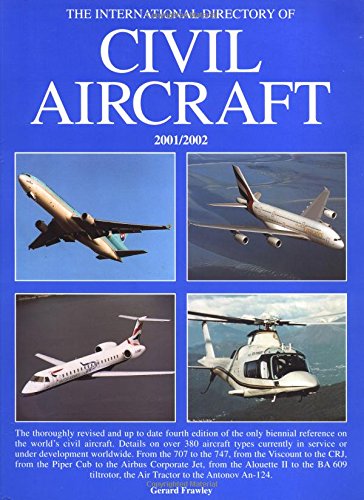The International Directory of Civil Aircraft 2001/2002
Gerard Frawley
About the Book
Description:
New Copy. Customer Service Guaranteed. Seller Inventory # think1875671528
About this title:
Synopsis: Book by Gerard Frawley
Excerpt. © Reprinted by permission. All rights reserved.: The following is the entry for 737-100 and -200, and is representative of the other entries in the book:
Boeing 737-100 & -200 Country of origin: United States of America Type: Short range narrowbody airliner Powerplants: 737-100 Two 62.3kN (14,000lb) Pratt & Whitney JT8D-7 turbofans. 737-200 Two 64.5kN (14,500lb) JT8D-9As, or two 68.9kN (15,500lb) JT8D-15s, or two 71.2kN (16,000lb) JT8D-17s, or two 77.4kN (17,400lb) JT8D-17Rs with automatic reverse thrust. Performance: 737-100 Max speed 943km/h (509kt), economical cruising speed 852km/h (460kt). Range with max fuel 2855km (1540nm). 737-200 Max speed 943km/h (509kt), max cruising speed 927km/h (500kt), economical cruising speed 796km/h (430kt). Range with 115 passengers and reserves between 3520km (1900nm) and 4260km (2300nm) depending on weight options and engines. Weights: 737-100 Empty 25,878kg (57,000lb), max takeoff 49,940kg (110,000lb). 737-200 Operating empty 27,448kg (60,600lb), max takeoff 52,390kg (115,500lb), or optionally 58,740kg (129,500lb). Dimensions: 737-100 Wing span 28.35m (93ft 0in), length 28.67m (94ft 0in), height 11.29m (37ft 0in). Wing area 91.1m2 (980sq ft). 737-200 Same except for length 30.53m (100ft 2in). Capacity: Flightcrew of two. 737-100 Typical single class seating for 100. 737-200 Typical single class seating for 115, max seating for 130 at 74cm (29in) pitch. 737-200C & QC payload 15,545kg (34,270lb), consisting of pallets or containers. Production: 1144 737-100s and 200s built, comprising 30 -100s and 1114 -200s, including various military models. Approximately 17 -100s and 925 737-200s remained in service in late 1998. Around 30 are used as corporate transports. History: The 737-100 and -200 are the first generation production models of the worlds most successful jet airliner family. The 737 was conceived as a short range small capacity airliner to round out the Boeing jet airliner family beneath the 727, 720 and 707. Announced in February 1965, the 737 was originally envisioned as a 60 to 85 seater, although following consultation with launch customer Lufthansa, a 100 seat design was settled upon. Design features included two underwing mounted turbofans and 60% structural and systems commonality with the 727, including the same fuselage cross section. The 737-100 made its first flight on April 9 1967 and entered service in February 1968. By this time however development of the larger capacity 1.93m (6ft 4in) stretched 737-200 was well advanced, and the first 737-200 flew for the first time on August 8 1967. Developments of the -200 include the -200C convertible and quick change -200QC, while an unprepared airfield kit was also offered. The definitive Advanced 737-200 appeared in 1971, featuring minor aerodynamic refinements and other improvements. Sales of the 737-200 far exceeded that of the shorter -100 and the 737-200 remained in production until 1988, by which time it had been superseded by the improved 737-300. Photo caption: A hushkit equipped 737-200 of Irelands RyanAir, wearing advertising for Kilkenny beer.
Bibliographic Details
Title: The International Directory of Civil ...
Publisher: Australian Aviation
Publication Date: 2001
Binding: Paperback
Condition: new
